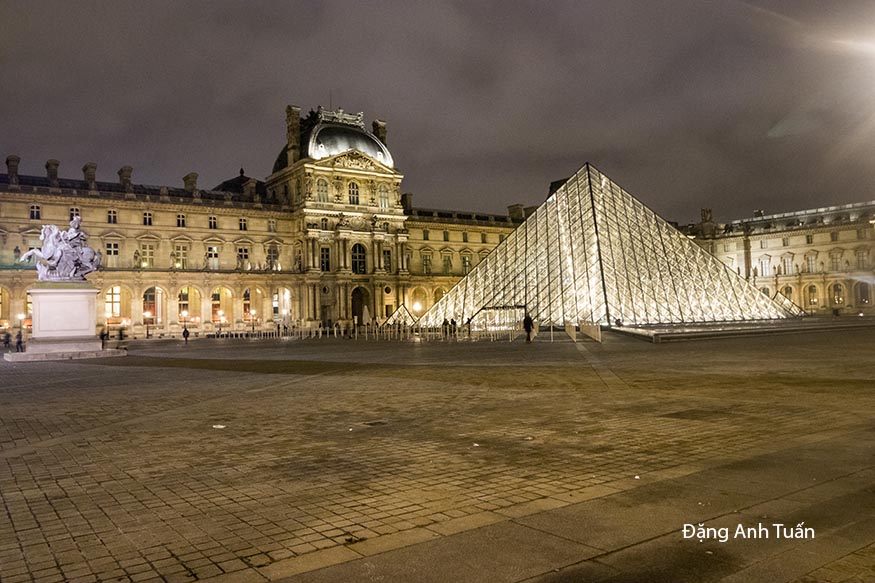La pyramide du Louvre au milieu de la cour Napoléon du musée Louvre
Version française
Version anglaise
Galerie des photos
Theo lời yêu cầu của cố tổng thống Pháp François Mitterand vào năm 1983, kim tự tháp kính Louvre được xây bằng kính và kim loại ở giữa sân Napoléon của bảo tàng Louvre. Đây là tác phẩm của kiến trúc sư người Mỹ gốc Hoa , ông Ieoh Ming người được nhận nhiều giải mà trong đó có giải Pritzkert thường đựợc xem là giải Nobel về kiến trúc. Khi kiến trúc sư Ieoh Ming thiết kế kim tự tháp Louvre, ông đã thiết kế nó theo cùng tỷ lệ với kim tự tháp Kheops. Kim tự tháp kính Louvre có bề cao là 21,64 thước với đáy hình vuông mỗi cạnh là 35,42 thước. Toàn bộ kim tự tháp được xây bằng kính cùng các khớp nối bằng kim loại , gồm có tất cả là 603 tấm kính hình thoi (losange) và 70 tấm hình tam giác (triangle). Lúc đầu kim tự tháp là môt đề tài tranh luận sôi nổi vì có người cho rằng không phù hợp với khung cảnh cổ kính của cung điện Louvre nhất là với phong cách vị lai. Nhưng cuối cùng sự kết hợp của hai phong cách kiến trúc cổ đại và hiện đại nó đem lại không những một kết quả mỹ mãn mà còn đem lại một nét đẹp độc nhất ở giữa thành phố Paris, một viên kim cương hoàn hảo của điện Louvre . Kim tự tháp kính Louvre trở thành hiện nay một trong những biểu tượng tham quan không thể thiếu xót cùng tháp Eiffel và nhà thờ Notre Dame de Paris khi ai có dịp đến tham quan Paris.
À la demande du feu président français François Mitterand en 1983, la pyramide du Louvre a été conçue et réalisée en verre et en acier au milieu de la cour Napoléon du musée Louvre. C’est l’œuvre de l’architecte américain d’origine chinoise Ieoh Ming ayant reçu plusieurs prix parmi lesquels figure le prix d’architecture Pritzker considéré jusqu’alors comme le prix Nobel de l’architecture. Quand l’architecte Ieoh Ming imagine la pyramide du Louvre, il lui donne les mêmes proportions que celles du Kheops. La pyramide du Louvre s’élève à 21,64 mètres sur une base carrée de 35,42 mètres de côté. Étant réalisé avec une structure métallique en acier et en aluminium, le tout de la pyramide comporte 603 losanges et 70 triangles en verre. Au début de sa construction, la pyramide du Louvre est l’objet d’âpres controverses car selon certains, la pyramide est mal incorporée dans le classicisme du palais Louvre avec un style futuriste. Mais finalement l’association de deux styles d’architecture classique et futuriste apporte non seulement un franc succès mais aussi un charme unique au cœur de la ville de Paris, un joyau d’architecture parfait du palais Louvre. La pyramide du Louvre devient aujourd’hui l’une des attractions touristiques qu’il est impossible de manquer avec la tour d’Eiffel et l’église Notre Dame lorsqu’on a l’occasion de visiter Paris. (8,9 millions en 2011).
At the request of the late French President François Mitterand in 1983, the Louvre Pyramid was designed and built in glass and steel in the middle of the Louvre’s Cour Napoléon. It is the work of Chinese-born American architect Ieoh Ming, whose many awards include the Pritzker Architecture Prize, considered until then to be the Nobel Prize for architecture. When Ieoh Ming designed the Louvre pyramid, he gave it the same proportions as those of Kheops. The Louvre pyramid rises to a height of 21.64 meters on a square base measuring 35.42 meters on each side. Constructed from a steel and aluminum structure, the pyramid features 603 rhombuses and 70 glass triangles. At the start of its construction, the Louvre Pyramid was the subject of bitter controversy, as some felt that the pyramid was poorly incorporated into the classicism of the Louvre Palace with its futuristic style. But in the end, the combination of classical and futuristic architectural styles not only proved a resounding success, it also added a unique charm to the heart of Paris, making the Louvre Palace a perfect architectural gem. Today, the Louvre Pyramid is one of the must-see tourist attractions, along with the Eiffel Tower and Notre Dame Church, when visiting Paris (8.9 million in 2011).

